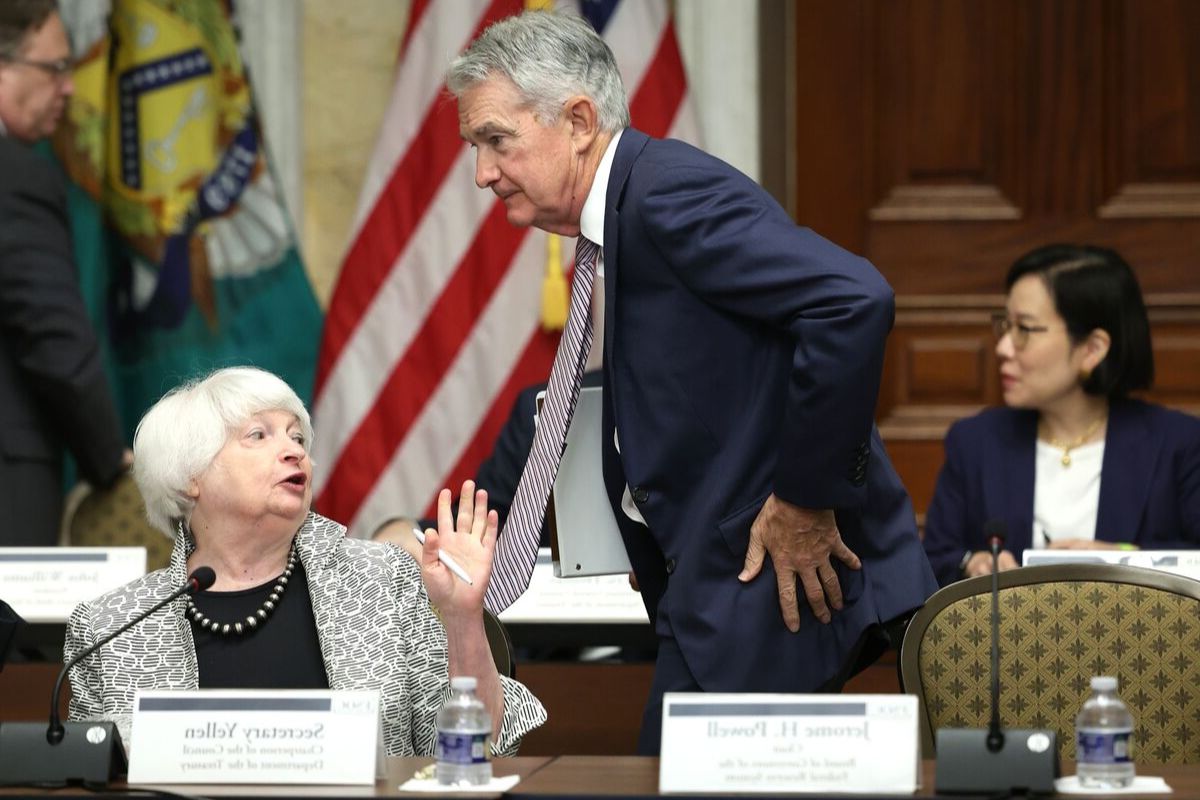US Treasury Investors Grapple: The recent announcements from the Federal Reserve regarding its stance on interest rates have left the US Treasury market in a state of uncertainty. As investors grapple with diverging expectations of rate cuts, the market is witnessing a clash of opinions and strategies. The reactions to these developments are proving to be pivotal in shaping the future of the market.
Moreover, the government’s bond issuance and investor caution are adding further complexity to an already intricate landscape. Amidst this uncertainty, it is intriguing to observe how equities are displaying resilience, hinting at a potential divergence in outcomes.
The post-Fed landscape is teeming with questions and potential opportunities, making it a topic worth exploring further.
Key Takeaways
- The Federal Reserve’s shifting stance on interest rates is causing uncertainty in the US Treasury market.
- Investors have diverging opinions on the timing and magnitude of potential rate cuts.
- Anticipations of $2 trillion in new government bond issuance in 2024 are adding to the uncertainty.
- Equities have shown resilience despite the uncertainty surrounding interest rates.
Federal Reserve’s Shifting Stance
The shifting stance of the Federal Reserve is causing uncertainty in the US Treasury market, as investors grapple with the potential impact of the central bank’s decisions on interest rates.
The surge in bond prices at the end of 2023, driven by the anticipation of early 2024 rate cuts, has encountered challenges after the release of strong US jobs data and a cautious message from the Fed. The central bank has hinted at potential inflationary risks if rates are cut prematurely, prompting a reassessment of rate cut bets by investors. As a result, yields on the 10-year Treasury have risen 20 basis points from their December lows.
Also Read: US Treasury Bonds Face Growing Challenges Amid Economic Forces
This uncertainty in the Treasury market reflects the delicate balance the Federal Reserve must strike between supporting economic growth and managing inflationary pressures. Investors are closely monitoring the Fed’s shifting stance to navigate the evolving landscape of the US Treasury market.
Investor Divergence on Rate Cut Expectations
Amidst the uncertainty surrounding the shifting stance of the Federal Reserve, investors find themselves diverging on their expectations for rate cuts, grappling with the timing and magnitude of potential adjustments.
Initially, investors were anticipating multiple rate cuts, but the recent jobs report and statements from Fed Chair Jerome Powell have led to differing opinions. The probability of a March rate cut has dropped significantly, now standing at only 20%. Powell dismissed expectations for a March rate cut, emphasizing the need for confidence in inflation approaching the 2% target.
However, investors now see a higher probability of a rate cut in May, with a 55% chance. Overall, market participants are pricing in a total of 122 basis points in cuts for 2024. These divergent expectations reflect the uncertainty and complexity surrounding the Federal Reserve’s decision-making process.
Market Reactions and Strategies
Investors in the US Treasury Investors are grappling with uncertainty and varied reactions as they navigate the shifting stance of the Federal Reserve. The recent Treasury pullback has prompted different responses from market players. Some view it as an opportunity to buy the dip, while others question the sustainability of last year’s bond rally. Concerns about increased bond supply from government issuance further dampen bullish sentiment. In response to the possibility of elevated rates for a more extended period, some investors have reduced exposure to long-term Treasuries and shifted their focus to shorter-term ones to mitigate interest rate risk.
To provide a clearer picture, let’s analyze the market reactions and strategies in the following table:
| Reaction | Strategy |
|---|---|
| Buy the dip | Take advantage of lower Treasury prices to enter or add to positions. |
| Question rally | Express skepticism about the sustainability of the bond rally. |
| Dampened sentiment | Concerns about increased bond supply from government issuance limit bullish sentiment. |
| Reduce exposure | Mitigate interest rate risk by reducing exposure to long-term Treasuries and focusing on shorter-term ones. |
These reactions and strategies reflect the uncertainty prevailing in the US Treasury market as investors adapt to the evolving stance of the Federal Reserve.
Government Bond Issuance and Caution
Navigating the shifting stance of the Federal Reserve, the uncertainty surrounding the US Treasury market is further compounded by the anticipations of $2 trillion in new government bond issuance in 2024, prompting investor caution and raising questions about the potential impact on the fixed-income market.
With the expected influx of new government bonds, investors are exercising caution as they assess the potential implications for yields and market dynamics.
The increased supply of bonds may lead to a decrease in prices and an increase in yields, as issuers may need to offer higher interest rates to attract buyers.
This could result in a shift in investor preferences towards higher-yielding assets, potentially impacting the demand for other fixed-income instruments.
Market participants are closely monitoring the situation, evaluating the potential risks and adjusting their portfolios accordingly to navigate the uncertainties ahead.
As the US Treasury market faces these dual challenges of Federal Reserve decisions and government bond issuance, it remains to be seen how investors will adapt to the changing landscape of the fixed-income market.
Equities Resilience Amidst Rate Uncertainty
Equities have displayed remarkable resilience in the face of uncertainty surrounding interest rates, maintaining strong performance and nearing record highs. Despite the rise in yields, the S&P 500 has surged more than 4% this year, defying expectations.
This resilience can be attributed to conflicting views among market participants. Some anticipate a direction towards lower rates as long as inflation remains subdued. While strong economic data has led to adjustments in the timing of rate cuts, the overall trajectory towards lower rates may still be maintained.
Investors have taken solace in the fact that the Federal Reserve will continue to support the economy, even if it means a slower pace of rate cuts. This has contributed to the equities market’s ability to weather the uncertainty surrounding interest rates and maintain its upward trajectory.
Conclusion Of US Treasury Investors Grapple
In conclusion, the US Treasury Investors faces a period of uncertainty following the Federal Reserve’s announcements. With investors diverging on their expectations for rate cuts, the market reactions and strategies remain uncertain.
Government bond issuance may be approached with caution as the market adjusts to the shifting stance of the Federal Reserve. However, equities have shown resilience amidst the rate uncertainty, providing some stability in an otherwise uncertain market.
Our Reader’s Queries
Q1 What is a U.S. Treasury investment?
A Treasuries, commonly known as United States Treasury securities, represent debt obligations issued by the U.S. government. These securities are backed by the full faith and credit of the United States, supported by the government’s authority to tax and borrow.
Q2 Who are the top 4 owners of US debt?
A As of January 2023, the top five nations holding the largest share of U.S. debt are Japan ($1.1 trillion), China ($859 billion), the United Kingdom ($668 billion), Belgium ($331 billion), and Luxembourg ($318 billion).
Q3 What are the 3 types of U.S. Treasury securities?
A These encompass Treasury Bills, Treasury Bonds, and Treasury Notes. Individuals can acquire these Treasury securities directly from the U.S. government via the website TreasuryDirect.gov or through financial institutions such as banks or brokers.



